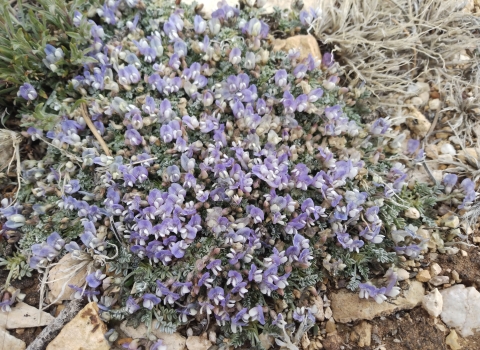ALBUQUERQUE, NM— The U.S. Fish and Wildlife Service has determined that the Sacramento Mountains checkerspot butterfly is at risk of extinction, due to the reduction of habitat quality and quantity, specifically the reduction in availability of host plants and nectar sources from overgrazing by large ungulates, recreation, climate change climate change
Climate change includes both global warming driven by human-induced emissions of greenhouse gases and the resulting large-scale shifts in weather patterns. Though there have been previous periods of climatic change, since the mid-20th century humans have had an unprecedented impact on Earth's climate system and caused change on a global scale.
Learn more about climate change , nonnative plants, and an altered wildfire regime. As such, the Service is proposing to list it as endangered under the Endangered Species Act (ESA).
“In recent years, the ecosystem where the Sacramento Mountains checkerspot butterfly lives has been degraded by prolonged drought, overgrazing, human recreation, and non-native plants,” said Amy Lueders, Service Regional Director. “With nowhere else to go, this rare butterfly is now facing a high risk of extinction.”
The Sacramento Mountains checkerspot butterfly (Euphydryas anicia cloudcrofti) is currently recognized as a subspecies of the variable checkerspot butterfly. These butterflies are about two inches wide as adults and members of the brush-footed butterfly family, Nymphalidae. This subspecies is found in only a few meadows within the Sacramento Mountains on the Lincoln National Forest in southeastern New Mexico.
A team of Service biologists, in consultation with other species experts, recently compiled and assessed the best scientific and commercial data available on the status of the checkerspot butterfly, including the impacts of past and present factors (both negative and beneficial). This report determined that the butterfly’s small, isolated populations were being threatened by degraded habitat, caused by overgrazing, human recreation, and extreme drought brought on by climate change.
The Service has found that the designation of critical habitat for the Sacramento Mountains checkerspot butterfly is prudent, but we are unable to make a critical habitat determination at this time. The Service is continuing to consider what areas may be essential to the butterfly’s conservation and expects to propose a designation of critical habitat in the coming year.
The Service is partnering with the U.S. Forest Service, butterfly experts, and non-governmental organizations to restore butterfly habitat on the Lincoln National Forest.
The proposal to list the Sacramento Mountains checkerspot butterfly as endangered will publish in the Federal Register on January 25, 2022 under Docket No. FWS-R2-ES-2021-0069. Public comments will be accepted until March 28, 2022. We encourage the public, academia, tribes, federal and state agencies, industry and other stakeholders to review the proposal and provide comments.
Native pollinators such as the Sacramento Mountains checkerspot butterfly are critical to healthy, functioning ecosystems. The growing extinction crisis highlights the importance of the ESA and efforts to conserve species. It also underscores how human activity can impact wildlife and ecosystems by contributing to habitat loss, collection/overutilization, and invasive species invasive species
An invasive species is any plant or animal that has spread or been introduced into a new area where they are, or could, cause harm to the environment, economy, or human, animal, or plant health. Their unwelcome presence can destroy ecosystems and cost millions of dollars.
Learn more about invasive species and disease. The growing impacts of climate change are anticipated to exacerbate further these threats and their interactions for many species and ecosystems.
Stemming this extinction crisis is a central component of the Biden-Harris administration’s America the Beautiful initiative. This locally-led and voluntary effort aims to conserve, connect and restore 30 percent of lands and waters in the U.S. by 2030 while enhancing wildlife habitat and improving biodiversity.



